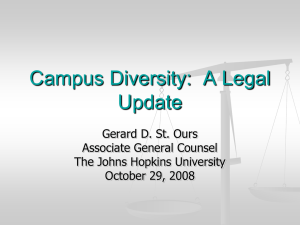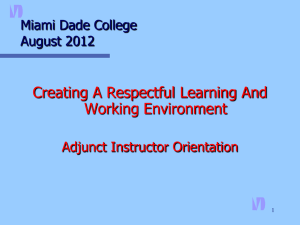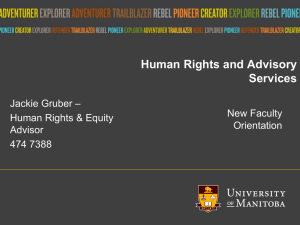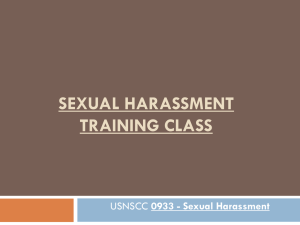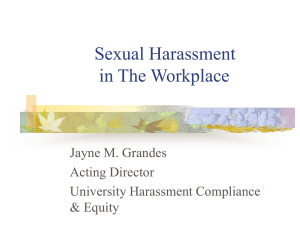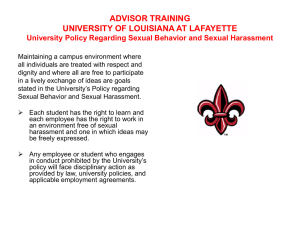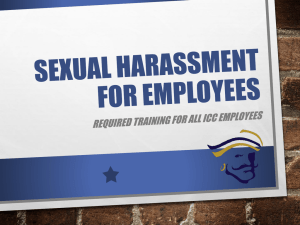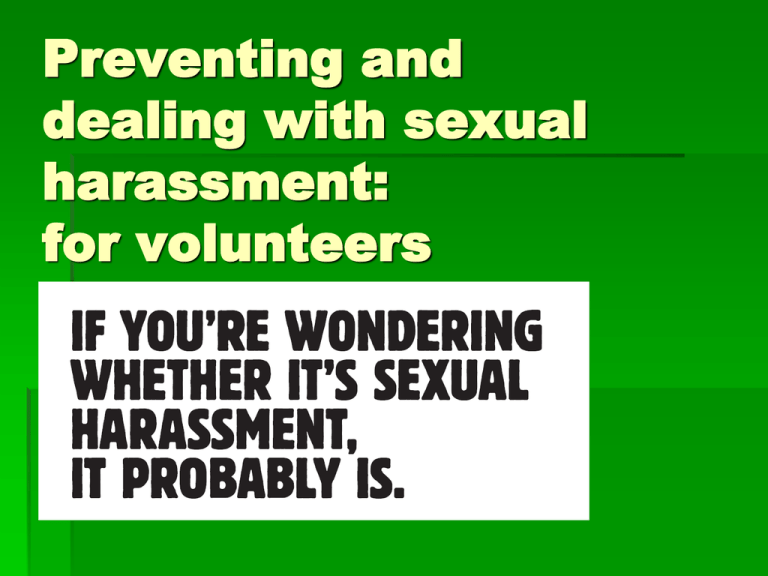
Preventing and
dealing with sexual
harassment:
for volunteers
Sexual harassment and
volunteers
The sexual harassment
provisions under Part 6 of the
Equal Opportunity Act 2010
now apply to volunteers in the
same way as they apply to
paid staff
Sexual harassment and
volunteers
This means that:
Volunteers have the right not to be sexually
harassed by their employer, a paid staff
member, another volunteer or a service user
Volunteers have an obligation not to sexually
harass their employer, a paid staff member,
another volunteer or a service user
Organisations’ sexual harassment policies
will need to cover volunteers
Sexual harassment is…
unwelcome conduct of a sexual
nature
behaviour that could reasonably
be expected to make a person feel
offended, humiliated or intimidated
Sexual harassment can be physical,
verbal or written
Examples of sexual harassment:
persistent, unwelcome demands or
even subtle pressure for sexual favours
or dates
leering, touching or unnecessary
intrusion into someone’s personal space
offensive jokes and comments, namecalling, intrusive questions, speculation
about another person’s physical
appearance or private life
Continued…/
Examples of sexual harassment:
Continued…/
displaying or sending pornography
(especially when it is directed at
particular individuals) ranging from
material that might be considered mildly
erotic through to material that is
sexually explicit
use of mobile phones (text messaging),
emails, notice-boards or any other
workplace communication method for
any of the above.
By the way…
A single incident is enough to
constitute sexual harassment – it
doesn’t have to be repeated.
It is also against the law to victimise
someone because they have made
a complaint of sexual harassment.
Scenarios
Mick
You have been minding an information
stall for the Cancer Council at a
shopping mall in the city. Mick, a
member of the public approaches you
and starts chatting you up. He hangs
around too long and will not take no for
an answer.
Clem
GAY FM, a community radio station has
organised for a new volunteer to receive
training in operating the sound mixing
equipment. The trainer, Brian, asks the
volunteer, Clem out on a date.
Pam
A women’s club have organised a
baked good stall at the local agricultural
show and are packing up at the end of
the day. Local council staff have arrived
to pack up the tent they have been
using. One of the paid council workers
makes suggestive comments to Pam, a
member of the group, and wolf-whistles.
The other council staff laugh and join in.
Tony
A local religious group organises a
prisoner visitors program at a low
security prison facility nearby. A male
visitor, Tony, regularly visits Pham, who
is serving 10 years for drug trafficking.
Pham has mental health issues and is
sometimes difficult to visit. He swears
and makes derogatory comments of a
sexual nature to Tony.
Peter
Peter, a retiree, is a volunteer delivering
meals on wheels through a local government
organised program. He is the only male in a
team of 18 women. The women often make
jokes about Peter being the only man, and
make sexual comments about their husbands
in front of him. They ask him questions about
his ‘love life’. Their teasing is starting to upset
Peter and he approaches the service
coordinator to talk about the problem. The
coordinator says he should think about
leaving if he finds it hard to fit in with the
team.
Anne
A local RSL club runs a professional
development weekend for staff and
volunteers. After the weekend, an email
is sent around to participants from John,
with suggestive comments about Anne.
Naw Say
Naw Say is a recently arrived refugee
from the Thailand-Burma border who is
assisting a local academic Ivan, with
some research on her community’s
settlement issues. Ivan, the lead
researcher asks her to have sex with
him. She says no. He rings her at home
and continues to ask for dates.
When is it a criminal offence?
Some types of sexual harassment
can also be a criminal offence.
These include indecent exposure,
stalking and sexual assault, as well
as obscene or threatening phone
calls, letters, emails, text messages
and posts on social networking
sites.
Sexual harassment is not…
behaviour which is based on mutual
attraction, friendship and respect;
if the interaction is consensual,
welcome and reciprocated, is not
sexual harassment.
Dealing with complaints
1.
2.
3.
4.
Self-management – complainant deals
directly with the respondent
Informal – manager or supervisor
assistance
Internal complaint– investigation to test
allegation. Finding. Recommendation.
External complaint– i.e. VEOHRC,
Worksafe, Police
What should organisations do
to prevent sexual
harassment?
19
What is the positive duty?
Organisations must take reasonable and
proportionate preventative measures to
identify and eliminate sexual harassment …
That is, think about where in your
organisation or service sexual
harassment might happen and take steps
to prevent that.
20
In other words…
Instead of organisations simply
reacting to complaints when they
happen, the Act requires organisations
to take steps to prevent sexual
harassment from happening in the first
place
21
Reasonable measures?
Organisations must take reasonable and
proportionate preventative measures to
identify and eliminate sexual harassment,
taking into account:
the nature of the organisation
its size, resources and operational
priorities
the practicability and cost of
compliance.
22
Discuss at your tables…
What are some steps that you /
your organisation might take to
prevent sexual harassment from
happening?
23
Checklist
Sexual harassment policy?
Grievance/ complaints policy?
Where to complain?
Handle complaints well?
Communicate policies?
Records of who has received the policies
or been trained?
Regular reminders & updates?
Job descriptions for volunteers?
24


